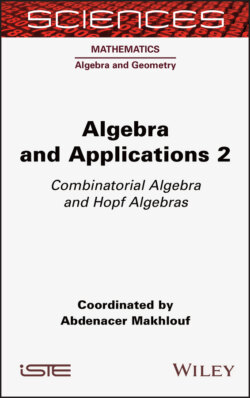Читать книгу Algebra and Applications 2 - Группа авторов - Страница 20
1.3.2. An example: the Hopf algebra of decorated rooted trees
ОглавлениеA rooted tree is an oriented graph with a finite number of vertices, one among them being distinguished as the root, such that any vertex admits exactly one outgoing edge, except the root which has no outgoing edges. Here is the list of rooted trees up to five vertices, where the edges are tacitly oriented from top to bottom:
A rooted forest is a finite collection of rooted trees. The Connes-Kreimer Hopf algebra is the Hopf algebra of rooted forests over k, graded by the number of vertices. It is the free commutative algebra on the linear space spanned by nonempty rooted trees. The coproduct on a rooted forest u (i.e. a product of rooted trees) is described as follows: the set U of vertices of a forest u is endowed with a partial order defined by x ≤ y if and only if there is a path from a root to y passing through x. Any subset W of the set of vertices U of u defines a subforest w of u in an obvious manner, that is, by keeping the edges of u which link two elements of W. The coproduct is then defined by:
[1.8]
Here, the notation W < V means that y < x for any vertex x of v and any vertex y of w, such that x and y are comparable. Such a couple (V, W) is also called an admissible cut, with crown (or pruning) v and trunk w. We have, for example:
With the restriction that V and W will be nonempty (i.e. if V and W give rise to an ordered partition of U into two blocks), we get the restricted coproduct:
[1.9]
which is often displayed as Σ(u) u′ ⊗ u″ in Sweedler’s notation. The iterated restricted coproduct, in terms of ordered partitions of U into n blocks, writes:
[1.10]
and we get the full-iterated coproduct by allowing empty blocks in the formula above. The coassociativity of the coproduct follows immediately.
Note, however, that the relation < on the subsets of vertices is not transitive. The notation Vn < … < V1 is to be understood as Vi < Vj for any i > j, i, j ∈ {1,…,n}.
